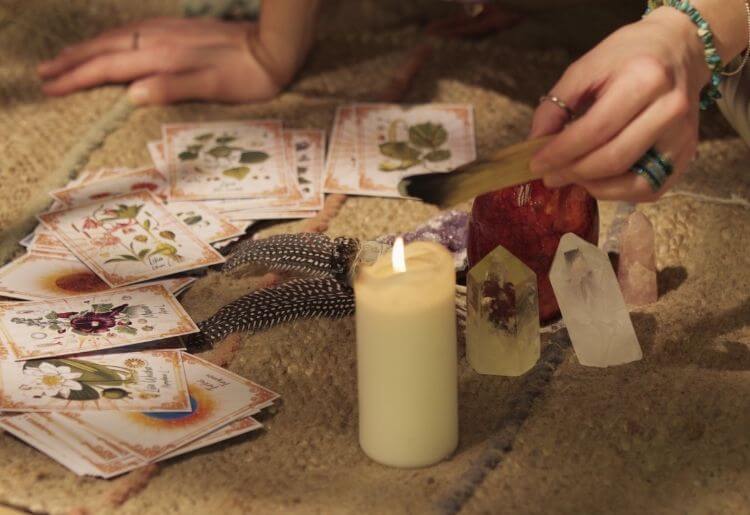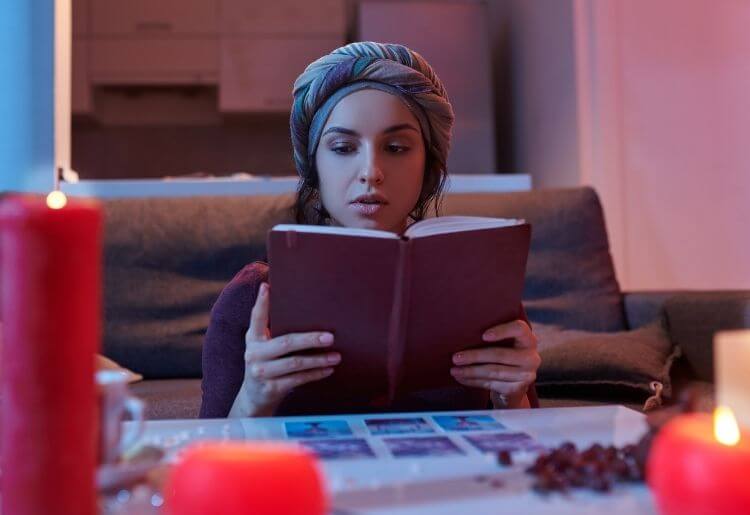Taking a quick glance through your deck, you’ll notice some common symbols: wands, cups, swords, and pentacles. They all have a real-world link you’re already familiar with, called suits—just like in a card game. And if you decide to get a psychic reading, do not be at all surprised if the psychic you choose decides to use tarot to help fortify their reading. Let’s jump right into what these symbols mean.
1. Wands: The Element of Fire
Are you a Harry Potter fan? Think of the wand that Harry holds and how all of the power, fire, and energy extend from its tip. The wand is a suit of action and represents the energy to do. It encompasses qualities such as spirituality, inspiration, and passion.
And just like with Harry, if the spell is not cast just right, the wand can misfire and cause unexpected trouble. Simply put, wands, just like fire, can be unpredictable and temperamental. A fire, when well-controlled, provides warmth, light, and even serenity. When the fire is out of control, it takes no prisoners, consuming everything in its path. This means the wand can also represent elements of destruction, volatility, and recklessness.
2. Cups: The Element of Water
The easiest way to remember what cups are symbolic of is to think of what goes in a cup—water. This suit is the emotion element of the tarot. You can interpret cups as feelings about ourselves and others, family, and love and relationships.
Water can be peaceful: who doesn’t enjoy a nice, blissful escape on a beach with the waves lapping gently against the shore? Cups are just that, representing peace, tranquility, flow, creativity, and psychic ability. However, troubled waters can be unstable and destructive like a tsunami heading toward the shoreline. This means that the cup can also represent emotional instability, denial of logic and facts, daydreaming, and living outside of reality.
3. Swords: The Element of Air
Surely, if you’ve watched any action movie, you’ve witnessed a character wielding a sword in battle. Think of the sound that the sword makes as it slices through the air at its target and you’ve discovered the easiest way to remember this suit’s element. Much like a sword, you can expect the message to be sharp, piercing, quick, and clear.
A sword is a weapon of great power and is ripe with discipline, power, clarity, wisdom, and fairness. Make no mistake, though—just like the air it’s associated with, the sword can be a furious release of tornadic destruction, leaving only rubble in its place. Its quickness and sharpness can sever, hurt, and penetrate. This suggests that the sword also symbolizes aggression, coldness, volatility, conflict, and confusion.
If you undertake a psychic or tarot reading with a reputable company like Keen, you’ll no doubt find that symbols play a very critical role in demystifying the message being delivered.
4. Pentacles: The Element of Earth
The suit of pentacles represents the last of the natural elements: earth. Pentacles are generally amazing to see in a reading because they’re symbolic of a firm foundation and resilience. The Judeo-Christian model had it correct when it offered that it’s better to have your house built upon a rock than upon sand. That’s the entire energetic offering of the pentacle.
Like the earth, the pentacle points to foundational stability and reliability in relation to the things that surround us—our finances, physical bodies, and sense of safety and security. The pentacle can be a very rewarding suit in the deck, but like the other suits, there is an equally unpredictable side. It also represents earthquake-like catastrophe, unreliability, feeling unsafe, scarcity, lack, and carelessness.

5. Red: The Root Chakra
Color symbology is vital in tarot. The colors correspond to chakras, which is just a fancy way of saying the various energy centers of your body. Each chakra is associated with a specific color and you can bet that any color which appears on a tarot card can be used as a tool to provide even more clarity.
For example, the color red represents the root chakra. Located at the base of your spine and associated with the earth element (just as the pentacles are), its responsibility is to keep you grounded, connected, stable, and in survival.
This could mean that passion, security, and safety are elements to draw upon to further infer the meaning of the card. Conversely, anxiety, anger, insecurity, and instability are also possible interpretations of this color when it shows up.
6. Orange: The Sacral Chakra
Located just below your belly button, the job of this energy center is to inspire and express creativity and the ability to enjoy life and have fun. Orange corresponds with the element of water as the suit of cups does.
As there is nothing accidental or coincidental in tarot or its symbols, know that each color on the card is completely intentional and when seeing orange, you can infer that joy, fun, humor, optimism, and inspiration may be part of its meaning. Nevertheless, there is a less vibrant aspect that this color could represent. Extreme sensitivity, pessimism, negative outlook, fear of judgment, and restlessness are other interpretations of this color.
7. Yellow: The Solar Plexus Chakra
This chakra, located just above your navel, is associated with the element of fire, like the suit of wands, and has quite an amazing job. It is responsible for gut feelings, inner knowings, and self-confidence. This energy center is also symbolic of knowledge, intelligence, and rebirth. It is quite literally the spark of fire that ignites the new beginnings and change this energy center generates.
Even with all its positive aspects, there is still a somber side that can’t be ignored. Egotism, aggression, anger, the need for control, extreme neediness and attachment, and victim mentality are some sobering aspects of this color.
8. Green: The Heart Chakra
Positioned directly on your heart, this energy center does exactly what you think it does—it’s associated with love for yourself and others, compassion, empathy, forgiveness, kindness, and acceptance. It also corresponds to the element of air, just as the suit of swords does. It is here that you may tend to feel most connected to others and may have the knowledge that there is no separation among us—instead, we are all one.
What tends to be haunting about this chakra is that it can also signify envy, jealousy, greed, disenchantment, lack of trust, relationship dysfunction, and feelings of disconnection and isolation.
9. Blue: The Throat Chakra
Situated at the throat or voice box, this chakra gives voice to the most genuine expression of yourself and your truths. It is associated with the element of Space. Here, you tend to speak and listen honestly, openly, fearlessly, creatively, and clearly, replete with understanding and connection to your Higher Self.
Like all other symbols presented before this one, there is an unfavorable side to this color. It can serve as the vehicle that drives fear of emotional expression, feeling misunderstood, apathy, unworthiness, resistance to forgiveness, being tongue-tied or lost for words, and general feelings of incompetence.
10. Indigo: The Third Eye (or Ajna) Chakra
Occupying the space between your eyebrows on your forehead and associated with the element of light, the symbol of the third eye is centered around psychic energy, insight, intuition, expansion of consciousness, visualization, and manifestation.
Books like The Secret by Rhonda Byrne and Breaking the Habit of Being Yourself by Dr. Joe Dispenza are almost exclusively centered around the power contained in this energy center. It draws attention to the idea that you create 100% of your own reality.
Adversely, this color can mean disconnection from our true self, indecisiveness, confusion, anxiety, depression, fear, eccentricity, disorientation, and even having nightmares. Also housed within this color are elements of spiritual rejection, purposelessness, lack of clarity, and narrow-mindedness.
Conclusion
The tarot is full of wisdom and symbolism, so much so that it would be nearly impossible to cover everything in one sitting. While it may seem overwhelming initially, the most important thing is to have fun learning and realize that everything you see is intentional.
It’s for this reason I always encourage those new to tarot to get a tarot reading by a reputable company like Kasamba. Seeing the cards read and in action can be a very eye-opening experience and lend invaluable insight.
It may be helpful to think of tarot in the same way as the picture books we once read as children–telling a story with minimal context. While it’s important to know the basics of tarot symbols, do not obsess over attempting to memorize everything.
Instead, pay attention to what’s directly in front of you. You may find that you instinctively understand more than you initially thought in the same way you did as a child with picture books.

